Marching bands are a fundamental part of sporting events, parades, and other festive activities. While marching bands are widely used for entertainment today, they trace their history to the military, specifically the army of the Ottoman Empire. Today, most of the oldest/longest running marching bands in the military come from various regiments of the British Army or American colleges.
9. Purdue All-American Marching Band
Year Established: 1886
Country of Origin: West Lafayette, Indiana, USA
Associated Institution: Purdue University
Band Style: Traditional
Current No. of Members: about 389
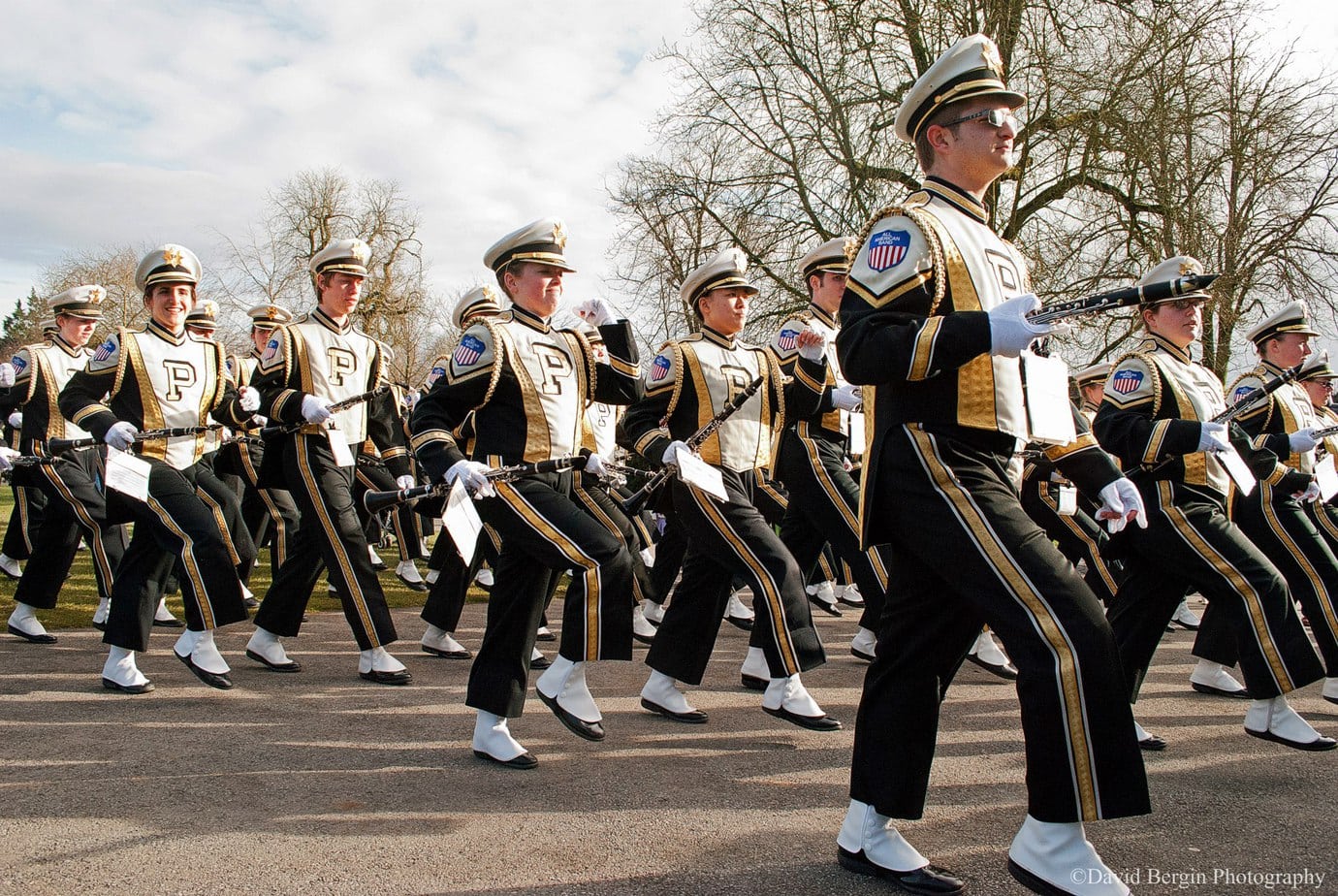 photo source: Flickr via David Bergin
photo source: Flickr via David Bergin
The Purdue All-American Marching Band is the second oldest college marching band in the United States. The band started out in 1886 as a small drum and bugle corps that was attached to the PSATC (Purdue Student Army Training Corps). The following year, the band grew in prominence when Purdue began playing football. Although the Purdue All-American Marching Band became important to the school, it operated without a permanent director until 1904.
There are many distinctive features of the Purdue All-American Marching Band, including the “World’s Largest Drum,” the Purdue Golden Girl featured twirler, and the “Block P” formation. Purdue All-American Marching Band was the first band to break traditional military formation to create a letter, a tradition now followed by many marching bands around the world. The Block P originated in 1907 under the direction of the band’s first director, Paul Spotts Emrick.
Did You Know?
The Purdue All-American Marching Band is so elite that each student must addition every year – previous membership in the band does not guarantee a position.
8. Christ’s Hospital School Band
Year Established: 1868
Country of Origin: England
Associated Institution: Christ’s Hospital School
Band Style: Unspecified
Current No. of Members: about 110
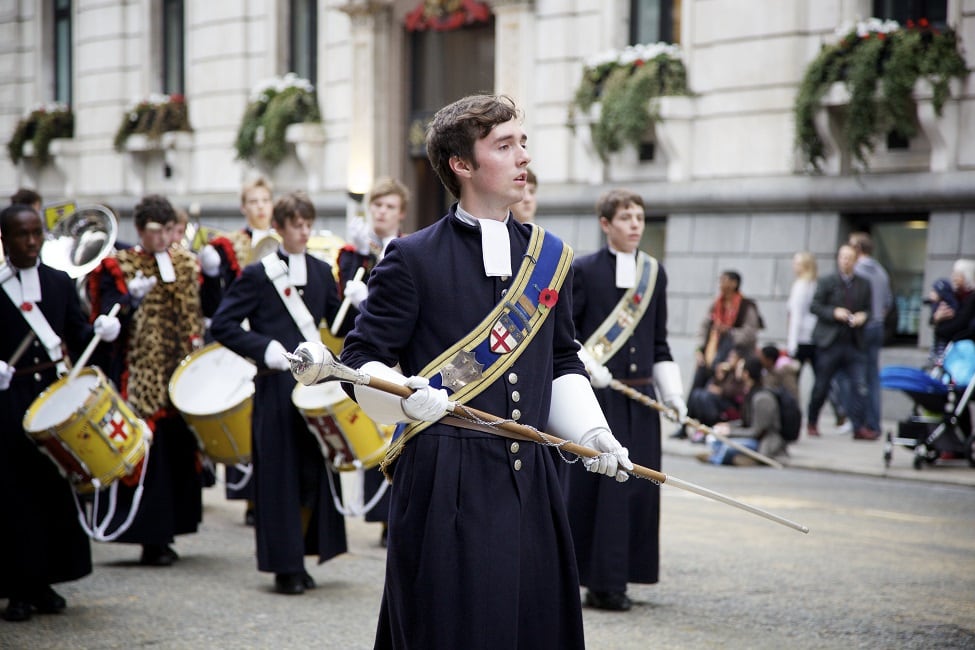 photo source: Wikimedia Commons via Aurelien Guichard
photo source: Wikimedia Commons via Aurelien Guichard
The Christ’s Hospital School Band is the only children’s marching band on this list. The band is the official marching band of Christ’s Hospital School in West Sussex, England. The school was founded in 1552 to provide education to underserved children (initially just boys, but the school is now co-ed).
While the Christ’s Hospital School Band was formally founded in 1868, a music program has been at the school since at least 1728. Daniel Defoe, the author of Robinson Crusoe, suggested to the Governors of Christ’s Hospital in London that thirty boys at the school should be encouraged to take up music in order to provide a pool of talent for national choirs, bands, and orchestras. Initially, the Christ’s Hospital School Band regularly accompanied the other students as they marched into the quadrangle and to the Dining Hall for lunch. In addition to school events, the Christ’s Hospital School Band no plays in London on St Matthew’s Day in September and at the Lord Mayor’s Show in November every year.
Did You Know?
Girls were not allowed to play in the Christ’s Hospital School Band until 1985 even though girls at the Christ’s Hospital branch in Hertford had been playing instruments since 1875.
7. Band of the Fighting Irish
Year Established: c.1846
Country of Origin: Notre Dame, Indiana, USA
Associated Institution: University of Notre Dame
Band Style: Traditional
Current No. of Members: about 376
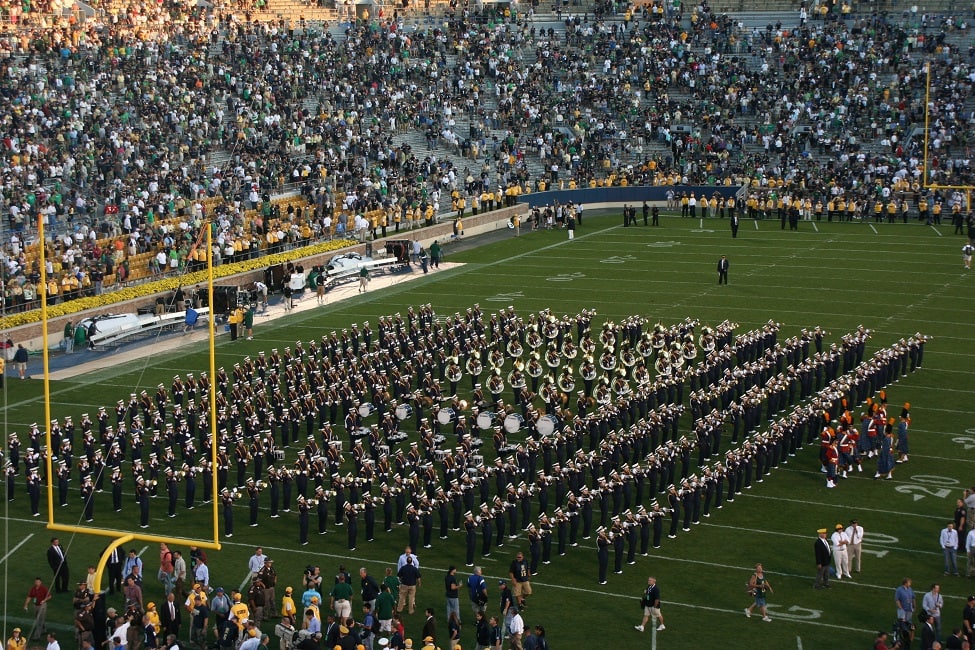 photo source: Wikimedia Commons via Ben Franske
photo source: Wikimedia Commons via Ben Franske
The Band of the Fighting Irish from the University of Notre Dame is the oldest college band in continuous existence. The band was formed just a few years after the University of Notre Dame was founded by Rev. Edward Sorin, C.S.C. In 1842. There is a possibility that that the Band of the Fighting Irish originated that same year as the school because music was so important to Rev. Sorin. However, the earliest mention of the band is in 1846 when the Band of the Fighting Irish performed at the university’s first graduation ceremony.
The Band of the Fighting Irish has always provided music and show for the university’s football games and played at the school’s first game in 1887. Since then, the Band of the Fighting Irish has not missed a home football game. In addition to football games, the Band of the Fighting Irish has boosted student morale through the years, and played as students left to join the armies during the Civil War, World War I, World War II, Korea, and Vietnam.
Did You Know?
Since 1949, the Band of the Fighting Irish has been led by the Irish Guard, a group of precision marchers who wear a uniform based on traditional Irish kilt.
6. Band of the Coldstream Guards
Year Established: May 16, 1785
Country of Origin: England
Associated Institution: Coldstream Guards of the British Army
Band Style: Military
Current No. of Members: 44
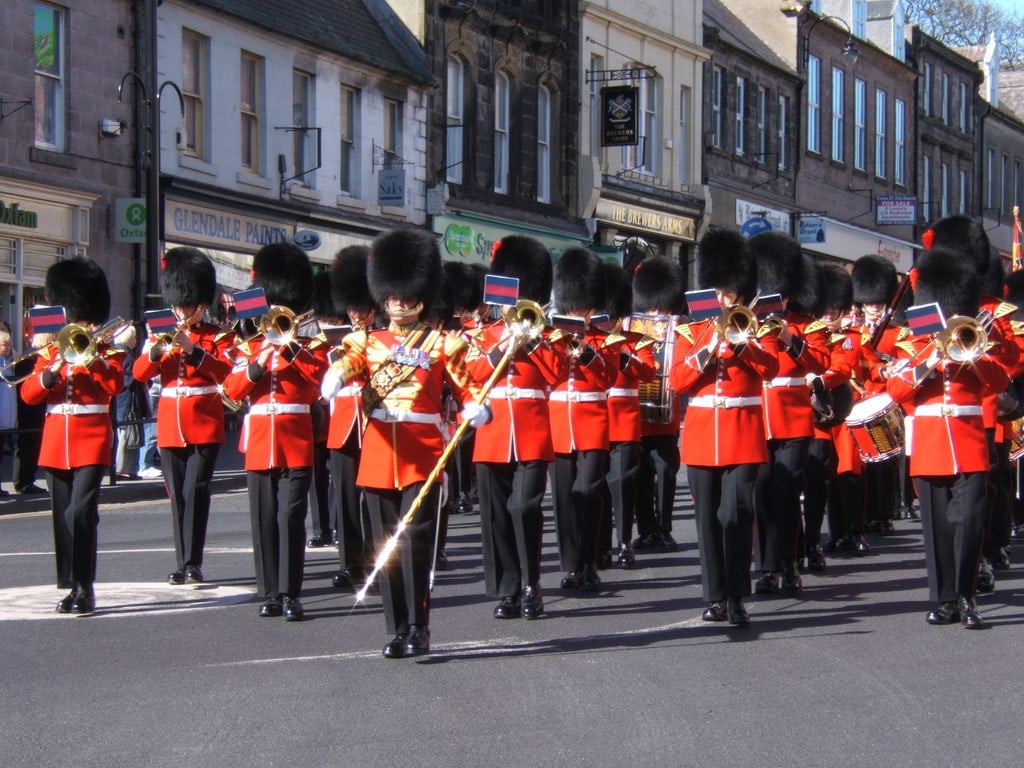 photo source: Geograph UK via Barbara Carr
photo source: Geograph UK via Barbara Carr
The Band of the Coldstream Guards is yet another British Army band that has been around for centuries. While the Band of the Coldstream Guards was officially founded on May 16, 1785, the regiment did have drummers and a “Band of Music” since at least 1742. These were civilian musicians and in 1785, they refused to perform at an aquatic excursion to Greenwich because they had prior engagements.
After this, the regiment’s officers asked the Duke of York, Colonel of the Regiment, for a regular attested band. Twelve musicians from Hanover, Germany were sent to England and the Band of the Coldstream Guards was officially founded. Over the years, the Band of the Coldstream Guards has served during important events such as the Battle of Waterloo.
Did You Know?
During World War II, the Band of the Coldstream Guards suffered its greatest tragedy when a German bomb was dropped on the Guards Chapel, Wellington Barracks where the band was playing – over 120 people died, including the Director of Music, Major Windram, and five musicians.
5. Band of the Scots Guards
Year Established: c.17th or 18th century
Country of Origin: Scotland
Associated Institution: Scots Guards (Foot Guards regiment of the British Army)
Band Style: Military
Current No. of Members: 49
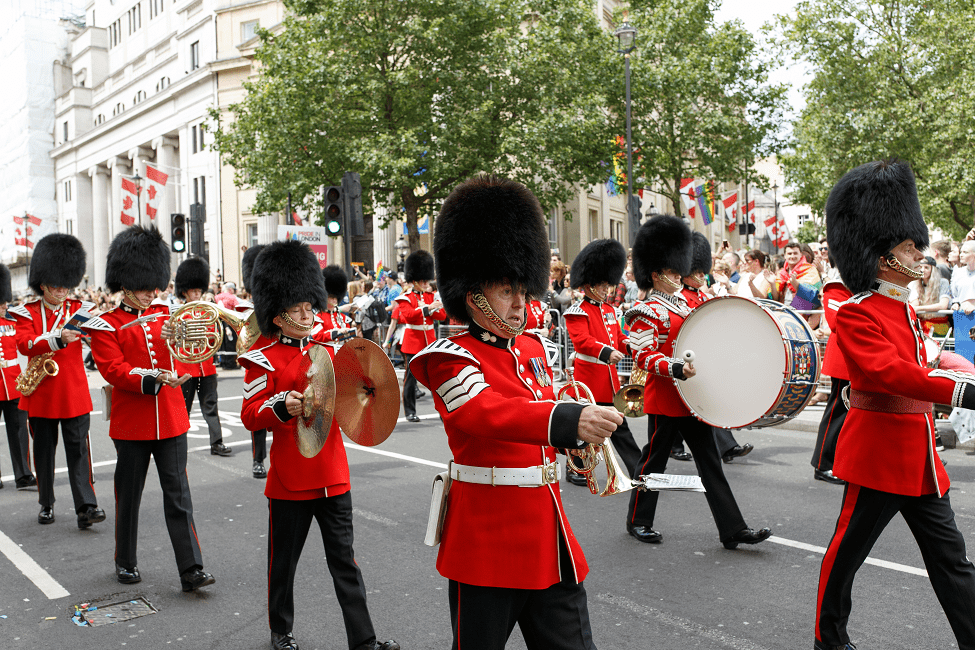 photo source: Wikimedia Commons via Katy Blackwood
photo source: Wikimedia Commons via Katy Blackwood
No one knows for sure when the Band of the Scots Guards was exactly founded, but the Scots Guards regiment was formed in 1642 by King Charles I. The band does cite the early 18th century as its founding and there is evidence that by 1716 a small band of “hautbouys” existed in the regiment.
The Band of the Scots Guards grew in strength in the early 19th century and by 1888, there were 44 members in the band. While members of the Scots Guards are full-time professional musicians, they are deployable soldiers and have had various military duties. Currently, the Band of the Scots Guards has 49 members.
Did You Know?
In 1990, during the Gulf War, the Band of the Scots Guards was the only Foot Guards Band to be deployed on active service.
4. Band of the Grenadier Guards
Year Established: c.1685
Country of Origin: England
Associated Institution: Grenadier Guards of the British Army
Band Style: Military
Current No. of Members: 42
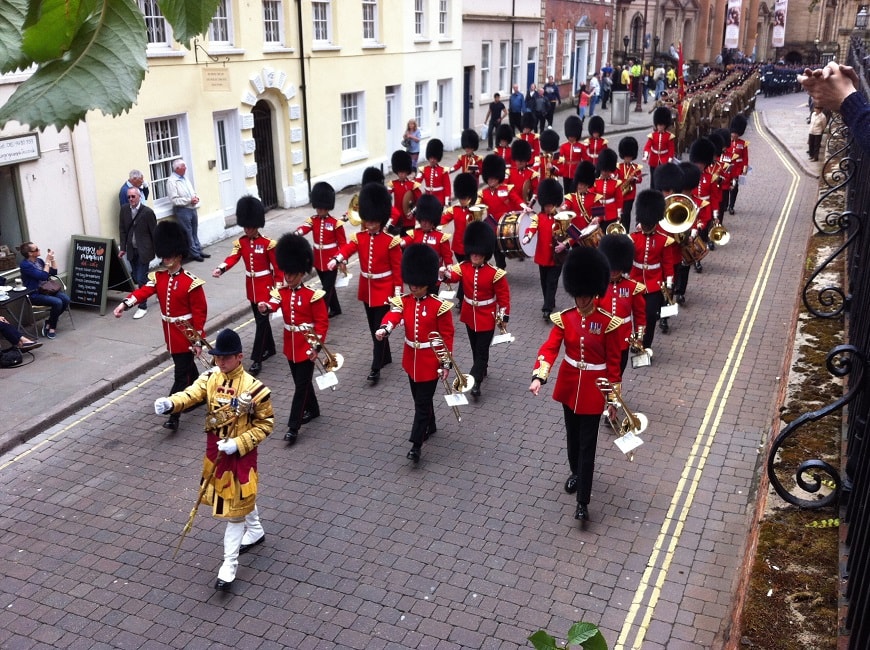 photo source: Wikimedia Commons via Andrewrabbott
photo source: Wikimedia Commons via Andrewrabbott
Although the Royal Artillery Band’s history dates to the mid-16th century, the Band of the Grenadier Guards is widely claimed to be the oldest band in the British military. This is somewhat true as the Band of the Grenadier Guards was founded in 1685, while the Royal Artillery Band was not formally adopted until 1762.
The Band of the Grenadier Guards was formed by King Charles II when he allowed the regiment to maintain 12 “hautbois” (oboe) players. Over the years, the size of the Band of the Grenadier Guards has varied and ranged in size from 12 to 19 players to 70 members in the 1970s. There are currently 42 members in the band. Since the Band of the Grenadier Guards is over 333 years old, it has been present at all of Britain’s major historical events.
Did You Know?
The death of King Charles II in 1685 was so significant to the Band of the Grenadier Guards that the the Bass Drummer (known officially as The Regimental Timebeater) wore a black armband in mourning until the World War II.
3. Royal Artillery Band
Year Established: c.1557
Country of Origin: England
Associated Institution: Royal Regiment of Artillery (British Army)
Band Style: Military
Current No. of Members: Unspecified
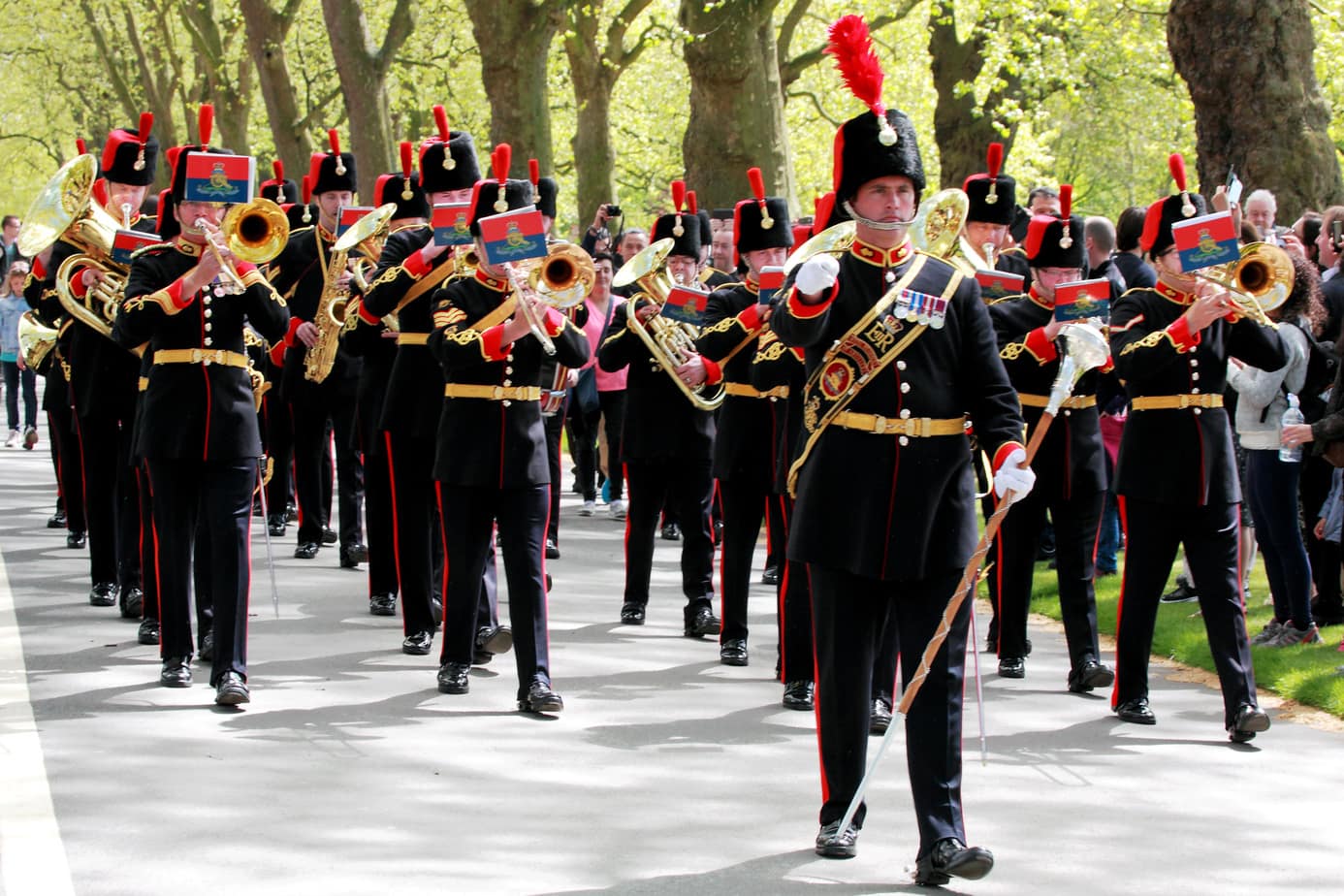 photo source: Wikimedia Commons via CAPTAIN ROGER FENTON 9th.WEST MIDDLESEX VRC. 1860
photo source: Wikimedia Commons via CAPTAIN ROGER FENTON 9th.WEST MIDDLESEX VRC. 1860
The Royal Artillery Band is Great Britain’s oldest military marching band. The band traces its history to 1557 during the battle of St. Quentin. Documents from the battle mention that the English Artillery had a “drumme and phife (or fyffe).” Over the next century there were various bands in throughout the English cavalry and foot guards regiments during campaigns, but they were disbanded when the fighting was done.
However, by at least 1751, the English Artillery had permanent drummers. The regiment also had civilian musicians who were hired by the English Artillery for certain events and disbanded after they were needed. In 1762, eight musicians were finally permanently hired by the regiment and the Royal Artillery Band was officially formed.
Did You Know?
The Royal Artillery Band’s uniforms are based on officers’ pattern ceremonial uniforms from the past and the British Artillery Band’s uniforms inspired the military band uniforms of the Royal Canadian Artillery, the Royal Australian Artillery, the Royal New Zealand Artillery, and the Royal Netherlands Army Artillery.
2. Guggenmusik
Year Established: c.16th century
Country of Origin: Alemanic region of Switzerland, Austria, and southern Germany
Associated Institution: None – bands play during Swabian-Alemannic Fastnacht carnivals
Band Style: Carnival
Current No. of Members: N/A
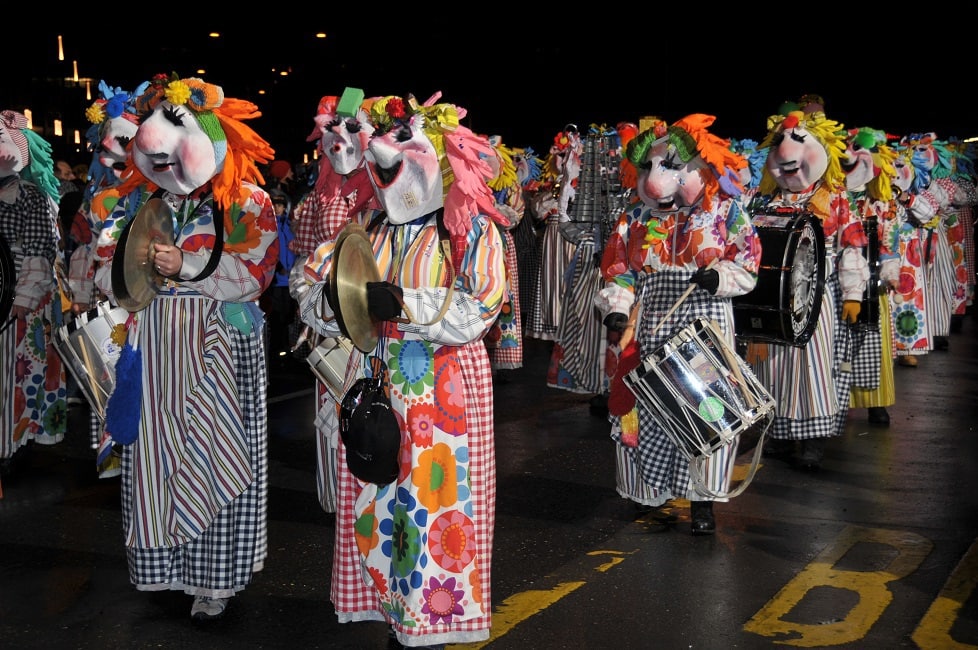 photo source: Wikimedia Commons via Hofec
photo source: Wikimedia Commons via Hofec
Like Turkish Mehter bands, Guggenmusik is the name of a Carnival type of marching band; it is also used to describe the type of music that the bands play. Guggenmusik is Alemannic region of Switzerland, Austria, and southern Germany and was first explicitly mentioned in the 16th century.
Guggenmusik is based on the folk custom of using loud horns to chase away “the spirits of winter.” The Carnival band members also wear colorful masks and costumes to frighten the spirits of winter. Today, Guggenmusik is still a major part of Swabian-Alemannic Fastnacht, which is a pre-Lenten carnival.
Did You Know?
The largest international Guggenmusik gathering is held annually in Schwäbisch Gmünd and attracts 60,000 to 100,000 visitors.
1. Turkish Mehter Bands
Year Established: c.13th century
Country of Origin: Turkey (Ottoman Empire)
Associated Institution: Mostly ceremonial but Turkish Armed Forces has a band
Band Style: Military
Current No. of Members: N/A
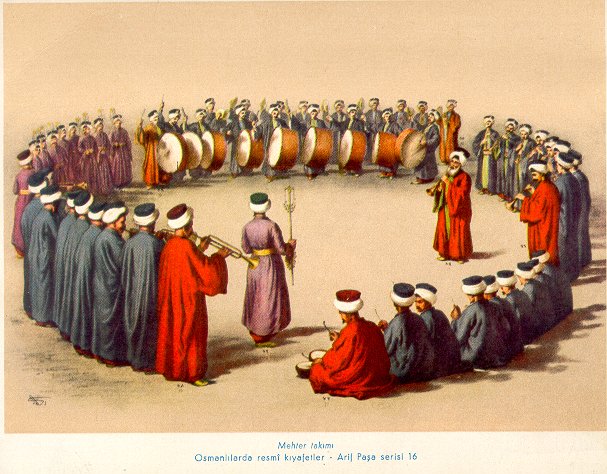 photo source: Wikimedia Commons
photo source: Wikimedia Commons
A Turkish Mehter band is a style of military band that is considered the oldest marching band in the world. Mehters are also known as Ottoman military bands because they date back to at least the 13th century when Turkey was the Ottoman Empire.
According to a number of sources, the first mehter was sent to Osman I by the Seljuk Sultan Alaeddin Keykubad III as a present along with a letter that salutes the newly formed state. After that, following every afternoon prayer, the mehter played for the Ottoman ruler.
In the mid-19th century, mehters fell out of fashion, but the tradition was revived in the later 20th century. Today, mehters are mostly ceremonial, but the Turkish Armed Forces has the the Armed Forces Mehter Unit (Mehter Bölüğü), which performs regularly.
Did You Know?
The traditional instruments used by a Turkish Mehter band include: the kös (a giant timpani drum), the nakare (a small kettledrum), the davul (a bass drum), the zil (cymbals), the kaba zurna (a bass variety of the zurna (wind instrument)), the boru (a kind of trumpet), and the cevgen (a kind of stick bearing small concealed bells).











